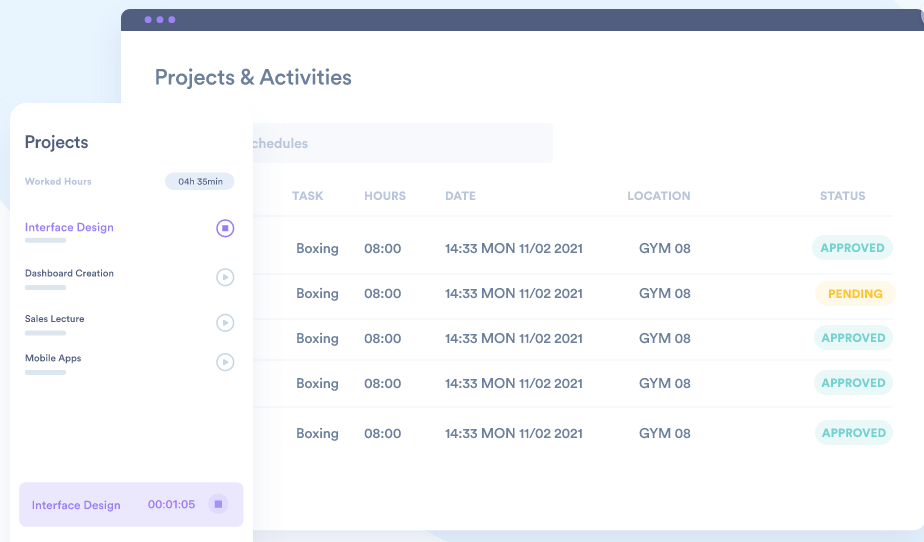As businesses and organizations embark on new projects, one of the most crucial aspects that you must consider is the project budget. Without proper monitoring and tracking, even the best-planned projects can quickly spiral out of control, leading to overspending, missed deadlines, and other unforeseen challenges.
Fortunately, there are numerous tips and tricks to help ensure that your project stays on track financially. This article will explore ten expert tips for perfect project budget tracking, allowing you to keep your project within budget and on schedule.
Throughout this article, we’ll discuss:
- What is Budget Tracking?
- The Importance of Budget Tracking
- Key Components of Budget Tracking
- 10 Tips for a Streamlined Project Budget Tracking Experience
- Wrap-up: Proactive Project Budget Tracking with the Best Budget Tracking App

What is Budget Tracking?
Budget tracking is monitoring income and expenses, ensuring projects stay within budget. Effective project budget tracking is crucial for businesses as it promotes financial accountability, efficient resource allocation, and improved decision-making.
The Importance of Budget Tracking
Budget tracking is a must for any project, as it allows managers to monitor costs, spot potential overspending issues early on, and adjust the budget as necessary. Let’s look at the importance of project budget tracking.
Financial Health Insights
A clear understanding of a project’s financial status is essential to ensure that it remains profitable and viable, and budget tracking is an effective tool for achieving this. By keeping track of expenses and revenue, you can quickly assess whether a project is on track financially, identify potential shortfalls or overruns, and make informed decisions based on real-time data.
Identification of Financial Issues
By monitoring expenses and revenue, you can identify potential issues early on and take corrective action before they become more significant problems. Additionally, budget tracking facilitates better risk management by identifying potential financial risks and enabling you to make informed decisions to mitigate them.
Cost Control and Optimization
By monitoring project expenses, you can identify areas where costs can be reduced or optimized and establish and maintain financial discipline within the organization. Additionally, budget tracking encourages more efficient use of resources, enabling you to make the most of your budget and achieve better results with fewer resources.

Key Components of Budget Tracking
There are several components and factors to consider when tracking a project budget.
Budget Planning
Budget planning involves developing a comprehensive and realistic project budget that accounts for all necessary expenses. It also includes allocating resources based on project requirements and priorities and establishing contingency plans for unforeseen expenses.
Effective budget planning ensures that the project stays on track financially and that all financial resources are utilized effectively.
Budget Monitoring
Budget Monitoring is regularly reviewing project financials to ensure budget compliance is essential to identifying variances between budgeted and actual expenses.
Project managers can adjust forecasts based on project progress and changing circumstances by monitoring the budget. This proactive approach to budget monitoring helps to mitigate any potential financial issues that may arise during the project and ensure that the project remains financially viable.
Budget Reporting
Providing stakeholders with timely and accurate financial updates is vital to effective project management. This includes communicating budget performance to relevant parties and ensuring transparency and accountability in project financial management. By keeping all stakeholders informed of the project’s financial status, project managers can ensure that all parties are working towards the same goals and objectives and that everyone is aware of any potential financial risks or issues.
10 Tips for a Streamlined Project Budget Tracking Experience
Project budget tracking can be daunting, but with the right tools and strategies, it can be a seamless and streamlined experience. Here are ten tips to help you stay on top of your project budget and keep it on track.
1. Set Clear Objectives and Milestones
Well-defined objectives and milestones provide direction and enable prioritization. Clear objectives align the budget with project goals, making monitoring progress and adjusting as needed easier.
Establishing Objectives
The first step to successful project budget tracking is to set clear objectives and milestones. Establish SMART (Specific, Measurable, Attainable, Relevant, Time-bound) objectives that align with the overall business goals of your organization. Ensure all team members know these objectives and their importance in achieving the desired outcome.
Defining Milestones
At the same time, breaking down projects into smaller tasks and assigning deadlines for each milestone is essential. Doing so allows you to monitor progress more efficiently and adjust if timelines become too tight or need to be extended. This will help keep your project on track and within budget.
2. Use a Dedicated Budget Tracking App or Software
Budget tracking apps and software to streamline budget management and improve accuracy and efficiency. Features of top project budget tracking apps include

Day.io
- Comprehensive project management features
- Time tracking and budgeting capabilities
- Customizable dashboards and reports
- Cost and billing details
- Timesheet creation
- Project report and analytics
Asana
- Task management and team collaboration tools
- Budget tracking in Asana with custom fields
- Integration with third-party apps
Basecamp
- Project management and team communication features
- Budget tracking through third-party integrations
- File sharing and collaboration tools
Compare pricing, features, and user-friendliness to find the perfect budget tracking software for your business.
3. Establish a Realistic Budget
Creating a realistic budget is essential for preventing overspending and maintaining project feasibility. When establishing a project budget, there are several factors to consider.
These include analyzing historical data from similar projects, conducting market research on industry trends and competitors, assessing available resources such as personnel, equipment, and materials, estimating project duration, and identifying potential risks and uncertainties.
Analyzing historical data from similar projects can help identify costs and resource usage trends and inform budget estimates and assumptions. Market research on industry trends and competitors can help identify potential cost-saving measures and monitor market fluctuations that could impact the project budget.
4. Monitor and Update Your Budget Regularly
Regular budget monitoring is crucial for keeping a project on track and detecting potential issues early. It ensures accuracy by reflecting changes in project scope and prevents overspending by adjusting for unexpected costs. It provides real-time insight into project financials and enables data-driven decision-making.
Use the following tips to update your budget effectively:
- Schedule regular budget review meetings,
- Use budget tracking software for real-time updates,
- Adjust budget forecasts based on actual expenses and project progress.
5. Implement a Contingency Plan
Contingency planning is crucial to effective project budget management. Unexpected expenses can arise at any point during a project, and without a contingency plan, it can be challenging to manage these costs effectively.
You may use the following contingency planning tips:
- Allocate a percentage of the project budget for contingencies
- Prioritize risks based on likelihood and potential impact
- Develop strategies to mitigate or address identified risks.

6. Communicate Budget Expectations with Your Team
Communicating budget expectations with your team is essential for project success. When team members understand the project budget and their role in managing project expenses, they are better equipped to make informed decisions and prioritize spending. This helps to prevent overspending, reduces the risk of budget overruns, and improves project outcomes. Some tips to follow:
- Hold regular meetings to discuss budget updates and concerns
- Maintain transparent reporting on project financials
- Encourage open dialogue among team members
- Provide training on budget tracking tools and best practices
7. Categorize and Track Expenses
Categorizing and tracking expenses provide benefits such as simplifying expense analysis, identifying trends in spending, detecting overspending early, and enhancing visibility into project financials. Organizing expenses into logical groups enables easy comparison of expenses across different categories and helps uncover recurring expenses that may require attention.
This facilitates proactive cost management and optimization efforts and supports quick action to address overspending and reallocate resources if necessary, minimizing the negative impact of overspending on the overall project budget.
You may use the following tips to streamline the process:
- Create expense categories based on project phases, tasks, or resources
- Use budget tracking software to automate expense categorization and tracking
- Regularly review expense reports and adjust budget allocations as needed
8. Analyze and Learn from Past Projects
Analyzing past projects is a crucial step toward improving project budget management. By identifying patterns in budget overruns or underestimations, project managers can make targeted improvements and refine budget estimates for future projects. This supports continuous improvement in budget management and enables the identification and adoption of best practices in the field.
Furthermore, analyzing past projects helps refine budgeting processes and methodologies, leading to the development of a more robust and accurate budgeting process. By providing valuable insights into the effectiveness of current budgeting practices, project managers can make informed decisions and implement data-driven strategies to ensure project success.
In addition to these benefits, analyzing past projects also provides valuable insights for future project budgeting. By informing future budget estimates based on historical project performance, project managers can better allocate resources and prioritize spending decisions.
This supports data-driven decision-making in project budgeting and ensures that projects are set up for success from the outset. Overall, analyzing past projects is a key component of effective project budget management, enabling project managers to learn from successes and failures and make continuous improvements for the future.
Here are some tips for analyzing and learning from past projects to improve budget tracking:
- Review completed projects and compare actual expenses to budget estimates
- Identify common causes of budget variances and develop strategies to address them
- Document lessons learned and incorporate them into future budgeting processes.
9. Involve Stakeholders in the Budgeting Process
Involving stakeholders in project budget tracking leverages their expertise and enhances buy-in and commitment. Several advantages include:
-
- Leverages the knowledge and experience of various team members: Stakeholders can bring a range of perspectives, insights, and expertise to the budgeting process, which can help to ensure that the budget is accurate, comprehensive, and aligned with project objectives.
- Enhances stakeholder commitment to project success: When stakeholders are actively involved in the budgeting process, they are more likely to feel invested in the project and its outcomes. This can lead to greater engagement, collaboration, and accountability, as stakeholders work together to ensure that the project stays on track and within budget.
- Facilitates collaboration and information sharing: By fostering a collaborative approach to budget tracking, project managers can help to build stronger relationships among stakeholders, which can be beneficial for the overall success of the project.
Here are some tips for engaging stakeholders in the budgeting process:
- Keep stakeholders informed of budget updates and project progress
- Solicit input on budget estimates and potential cost-saving measures
- Encourage collaboration and open discussion among stakeholders

Alt-text: Involving stakeholders in the budget tracking process improves engagement and morale
10. Measure the ROI of Your Projects
Measuring your projects’ return on investment (ROI) has numerous benefits that can help you make data-driven decisions and achieve project success. One of the most significant advantages is that it provides a quantifiable measure of project success, enabling you to evaluate project performance based on financial returns.
This can help you assess the project’s value and contribution to organizational goals, benchmark performance against industry standards, and compare performance against other investments.
Additionally, measuring ROI facilitates strategic decision-making by highlighting the relative value of different investments. It can also inform future budgeting and investment decisions by providing insights into the financial performance of past projects, identifying trends, patterns, and best practices in project budgeting and management, and guiding resource allocation and investment decisions based on project profitability and ROI.
By measuring ROI, you can ensure that your projects are aligned with organizational goals, make informed decisions, and achieve project success. The following best practices might come in handy when calculating and analyzing ROI:
- Determine project benefits, such as increased revenue or cost savings: To measure project ROI effectively, it is important to identify both tangible and intangible benefits resulting from project implementation, quantify project outcomes, and consider both short-term and long-term benefits when evaluating ROI.
- Compare project costs and returns to calculate ROI: To measure the ROI of a project, one should calculate it by dividing the net benefits of the project by its total costs. Alternative ROI metrics such as NPV or IRR should also be considered. Additionally, it’s important to compare the project’s ROI to organizational targets, industry benchmarks, or other investment opportunities.
- Use ROI data to identify areas for improvement and inform future budgeting efforts: Analyzing project ROI helps uncover trends and areas for improvement, which can be leveraged to refine budgeting processes, methodologies, and decision-making. Incorporating lessons learned from past project ROI analysis can inform future project planning and budgeting.

Wrap-up: Proactive Project Budget Tracking with the Best Budget Tracking App
Effective project budget tracking is crucial for financial control, efficient resource management, and informed decision-making. Apply these tips consistently, continuously evaluate and improve your processes, and embrace a proactive budget-tracking approach for successful budget management.
One tool that can help streamline your project budget-tracking experience is Day.io, the best budget tracking app on the market. With Day.io, you can easily monitor your project expenses, track your spending in real-time, and gain valuable insights into your budget performance.
Sign up for Day.io today and control your project time and budget management like never before. Don’t let financial surprises and budget overruns derail your projects – use Day.io to stay on top of your finances and make informed decisions every step of the way.
